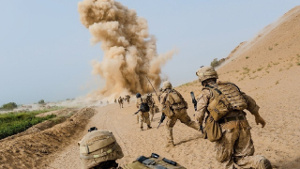The US is definitely going to be sending more ground troops to Afghanistan soon, but the exact number is yet to be determined, with the Pentagon today backing away from media reports yesterday that they’d settled on a figure of 4,000 more troops, saying no final decisions have been made yet on numbers.
 That might suggest they’re leaning toward an even bigger number, with influential retired Gen. Jack Keane suggesting that the US needed to send up to 20,000 more ground troops if they wanted to win the war, saying he believed the 4,000 figure was not likely to change the direction of the war.
That might suggest they’re leaning toward an even bigger number, with influential retired Gen. Jack Keane suggesting that the US needed to send up to 20,000 more ground troops if they wanted to win the war, saying he believed the 4,000 figure was not likely to change the direction of the war.
Defense Secretary James Mattis conceded in testimony to the Senate this week that the US is “not winning” in Afghanistan, and President Trump has since given him unilateral authority to decide on troop levels and strategy. Mattis was seen as leaning toward the high end of escalation proposals.
It’s not clear whether that means the 4,000 to 5,000 figures being bandied about by Pentagon officials, however, or if proposals by former officials for far bigger escalations, like Keane’s today, might have some traction. Keane explicitly faulted President Obama for removing the 100,000 troops the US had in Afghanistan at one point and leaving only around 8,000 insisting that “we have to put that back if they’re going to be effective.”
The Afghan War hasn’t exactly been popular, however, and while the roughly 8,500 troops there presently mostly fly under the radar, moves to double or triple the number of US troops in the country could prove very controversial, particularly since, 16 years into the war,the US seems further than ever from something resembling victory.


